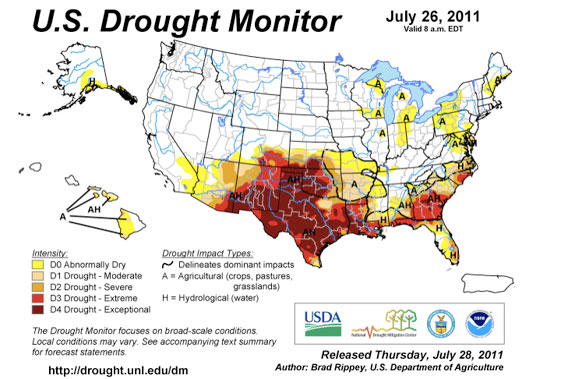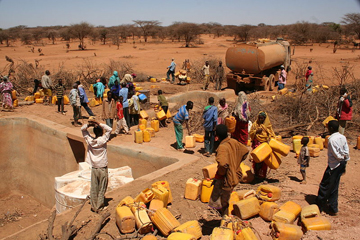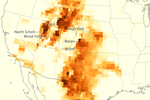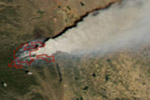
Map shows the level of drought and dryness across the US in July 2011. Map courtesy US Department of Agriculture. Click to enlarge.
Climate change is here and its increasing the chances for crazy weather, according to scientists. A prestigious group of climatologists have released a landmark report that makes the dramatic point that climate change is impacting our weather systems—and in turn our food crops, our economies, and even our lives—here-and-now. The new report in the American Meteorological Society is first of what is intended to be an annual offering that will attempt to tease out the connections between climate change and individual extreme weather events, such as heatwaves, droughts and floods.
“2011 will be remembered as a year of extreme events, both in the United States and around the world,” Kathryn D. Sullivan, deputy administrator with the National Oceanic and Atmospheric Association, said in a press release. “Every weather event that happens now takes place in the context of a changing global environment.”
For example, researchers found that climate change made last year’s devastating drought in Texas 20 times more likely than such an event would have been just fifty years ago.
“We found that extreme heat events were roughly 20 times more likely in 2008 than in other La Niña years in the 1960s and indications of an increase in frequency of low seasonal precipitation totals,” the researchers write, who used 2008 as a proxy for 2011 given data availability.
 Oxfam distributing water in southern Somalia during last years famine. Photo by: Oxfam. |
The Texas drought dried up water sources, decimated crops, forced ranchers to cull cattle herds, and killed hundreds of millions of trees. The state lost an estimated $7.62 billion in the cattle and agricultural industries.
An unusually warm November in Britain was also directly linked to a warming world. Scientists found that climate change made the abnormal warmth 60 times more likely. It was the second warmest November in Britain in the past 350 years.
“This does not mean that climate change can be blamed for every extreme weather or climate event. After all, there has always been extreme weather,” the scientists write. For example in analyzing an epic flood in Thailand last year, the researchers found no significant link to climate change, noting that “the amount of rain that fell in the catchment area was not very unusual.” Instead they say other hydrological factors played a more important role than a warmer world in that particular extreme weather event.
Still, the overall take-away from the report is that climate change is here, and it’s playing a significant role in disasters around the world.
In fact, arguably the most shocking finding in the report is the likely connection between climate change and drought in East Africa last year. Exacerbated by conflict and government instability, the drought propelled Somalia into famine conditions. Between 50,000 and 100,000 people, half of whom were likely children under five, died in the famine.
“While many nonclimatic factors contributed to this crisis (high global food prices, political instability, and chronic poverty, among others) failed rains […] played a critical role,” the scientists write.
They argue that a 0.7 degrees Celsius rise in sea surface temperatures in the Pacific and Indian oceans over the last fifty years has increased the probability for droughts and failed rains in the region.
“While La Niña [conditions last year] had a large role to play in the failure of the rains in East Africa, there is evidence that warming in the western Pacific–Indian Ocean warm pool has contributed to an increased frequency of droughts in this region,” the scientists write. Unlike the other analyses, however, the researchers were not ready to put a number on how much climate change has increased the probability of droughts in the region yet.
Still, the researchers add that their findings related to the East Africa drought are significant given the hurdles scientists face in collecting climate observations and modeling in developing countries, which do not have the same resources as industrial nations.
While the science of directly attributing extreme weather events to a warming planet is still young, it holds the potential of truly pinpointing just how rapidly and drastically the world is changing from global warming.
“While much work remains to be done in attribution science, to develop better observational datasets, to improve methodologies, to make further progress in understanding and to assess and improve climate models, the contributions in this article demonstrate the potential that already exists for meaningful assessments,” the scientists write.
To mitigate climate change, greenhouse gas emissions must be cut. Experts have long recommended moving rapidly and aggressively from fossil fuel energy sources to renewables, increasing energy efficiency, and protecting and restoring forests and other carbon-rich ecosystems. Despite decades of meetings with international leaders on the issue, global greenhouse gas emissions continue to rise.
Related articles
As U.S. sees record heat, extreme weather pummels 4 continents

(07/10/2012) It’s not only the U.S. that has experienced record-breaking extreme weather events recently, in the last couple months extreme weather has struck around the world with startling ferocity. In addition to the much-covered heatwaves, wildfires, and droughts in the U.S., killer floods struck India, the worst drought yet recorded plagued South Korea, and massive forest fires swept through Siberia to name just a few.
Scientist: ‘no doubt’ that climate change is playing a role in U.S. fires

(07/02/2012) A noted climate scientist says there is ‘no doubt’ that climate change is ‘playing a role’ in this year’s series of record fires in the western U.S. A massive wildfire in Colorado has forced the evacuation of 36,000 people, destroyed over 300 homes, and killed two people. The devastation wrought by the Waldo Canyon Fire even prompted a visit form U.S. President Barack Obama. But this is not the only epic fire in the U.S. this year: less than a month before the Colorado disaster, New Mexico experienced its largest fire on record in Gila Nation Forest; the conflagration burned up 247,000 acres (100,000 hectares). Other major wildfires have occurred in Utah and Wyoming, as well as other parts of New Mexico and Colorado.
As Colorado and New Mexico burn, scientists say prepare for more

(06/12/2012) A massive wildlife in Colorado still burns after it has killed one person and damaged or destroyed over a hundred structures. The fire, the third largest in Colorado’s history, has burned 39,500 acres (16,000 hectares) to date. Meanwhile in central New Mexico, another wildfire has damaged or destroyed 35 structures and burned 34,500 acres (14,000 hectares). This comes just weeks after New Mexico’s largest wildfire ever—still going—burned up over 247,000 acres (100,000 hectares) of the Gila Forest. Weeks of heroic efforts by thousands of firefighters have contained this megafire by only 37 percent to date. Now, a new scientific study in Ecospshere has found that North America and Europe must prepare for even more fires as global temperatures continue to rise from climate change.
NASA image: New Mexico suffers record megafire
(06/04/2012) To date, around 250,000 acres (101,000 hectares) of the Gila Forest in New Mexico have burned in the state’s largest fire ever recorded. Begun on May 16th due to lightning strikes, the unprecedented fire has likely been made possible by a combination of land-use changes, unflagging drought, and climate change.
The vanishing Niger River imperils tourism and livelihoods in the desert

(06/04/2012) Severely affected by recent turmoil across its northern frontiers, Nigerien tourism pins hope on river valley attractions to play a major role in rebuilding its tourism industry in the upcoming years. Even though the river itself is threatened. Located in the heart of the Sahel Region, the vast desert lands of Niger have captivated European tourists seeking a taste of its immensely varied natural landscapes.
U.S. undergoes warmest 12 months yet
(05/10/2012) Americans would not be remiss in asking, “is it getting hot in here?” According to new data from the National Oceanic and Atmospheric Administration (NOAA)’s National Climatic Data Center, the last twelve months (from May 2011 through April 2012) were the warmest on record for the lower 48 U.S. states since record keeping began in the late 19th Century.
Pictures of the day: activists highlight personal impacts of climate change worldwide
(05/07/2012) On Saturday, people around the world gathered to highlight the varied impacts of climate change on their lives. Organized by 350.org, the global day of action was a call to “connect the dots” between a warming Earth and extreme weather events, such as droughts, floods, and fires among other impacts. Nearly 1,000 events were held worldwide.
Thousands worldwide to “connect the dots” between climate change and extreme weather this weekend

(05/03/2012) On Saturday, May 5th vulnerable populations from the United States to Bangladesh will “connect the dots” between devastating extreme weather and climate change in a global day of action organized by 350.org. The nearly 1,000 events occurring in over half of the world’s nations are meant to highlight to governments, media, and the public that climate change is impacting lives through an increase in number and intensity of devastating weather events, such as droughts, heatwaves, and floods.
U.S. suffers warmest March, breaking over 15,000 record temperatures
(04/11/2012) March was the warmest ever recorded in the U.S. with record-keeping going back to 1895, according to new data by the National Oceanic and Atmospheric Administration (NOAA). But the month wasn’t just a record-breaker, it was shockingly aberrant: an extreme heatwave throughout much of the eastern and central U.S. shattered 15,272 day and nighttime records across the U.S. In all March 2012 was 0.5 degrees Fahrenheit above the previous warmest March in 1910, and an astounding 8.6 degrees Fahrenheit above the 20th Century average for March in the U.S.
“Strong evidence” linking extreme heatwaves, floods, and droughts to climate change
(03/28/2012) As North America recovers from what noted meteorologist Jeff Masters has called “the most incredible spring heatwave in U.S. and Canadian recorded history,” a new paper argues that climate change is playing an important role in a world that appears increasingly pummeled by extreme weather. Published in Nature Climate Change, the paper surveys recent studies of climate change and extreme weather and finds “strong evidence” of a link between a warming world and the frequency and intensity of droughts, floods, and heatwaves—such as the one that turned winter into summer in the U.S.